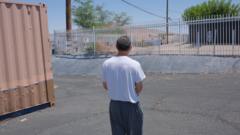Homeland Security Secretary Kristi Noem announced the plan to paint the US-Mexico border wall black, a strategy optimizing heat retention to hinder climbers. This decision, rooted in Trump's immigration policies, coincides with a significant reduction in border crossings.
New Painting Strategy for US-Mexico Border Wall Aims to Deter Climbing

New Painting Strategy for US-Mexico Border Wall Aims to Deter Climbing
The US-Mexico border wall will be painted black to increase heat and deter illegal crossings, a plan endorsed by Homeland Security.
The US-Mexico border wall is set to undergo a striking transformation as it will be painted black, a measure aimed to deter illegal crossings by making the structure hotter. Homeland Security Secretary Kristi Noem, who emphasized that the idea came from former President Donald Trump, highlighted that the plan is part of a broader immigration strategy amid declining border crossings.
An allocated sum of $46 million for additional border wall construction featured in a recent spending bill aims to enhance security along the nearly 2,000-mile border. Currently, about half a mile of new wall is being built each day, further fortifying the infrastructure.
During a press briefing along a section of the border in New Mexico, Noem explained that black paint will increase the intense heat in the hot climates of the desert, making it more challenging for individuals to attempt climbing the structure. Additionally, officials believe that black paint will contribute to preventing the wall from rusting, ensuring its longevity.
The Trump administration has reported a significant drop in border crossings, noting a record low of approximately 4,600 encounters in July, representing a staggering 92% decrease year-on-year when compared to the previous administration. While emphasizing the effectiveness of the new policies, Noem claimed that around 1.6 million undocumented immigrants have departed the US within the first 200 days of Trump’s return to office.
In tandem with the wall enhancements, plans are in place for increased "waterborne infrastructure" along the Rio Grande, which forms a substantial portion of the border. Previously, Texas has undertaken initiatives including the installation of floating barriers and reinforced riverbank enforcements guarded by state agencies.
Despite the claims of reduced crossings and heightened security, immigration advocates have raised concerns about the broader implications of these policies. They argue that while the administration professes to focus on individuals with criminal backgrounds, many individuals with minor infractions are caught in the enforcement sweeps.
The administration maintains that the combination of heightened border security measures and mass deportations are crucial factors leading to the decline in migrant encounters, a sentiment echoed by White House Press Secretary Karoline Leavitt, who noted that 300,000 undocumented immigrants have been detained since January 2023.























